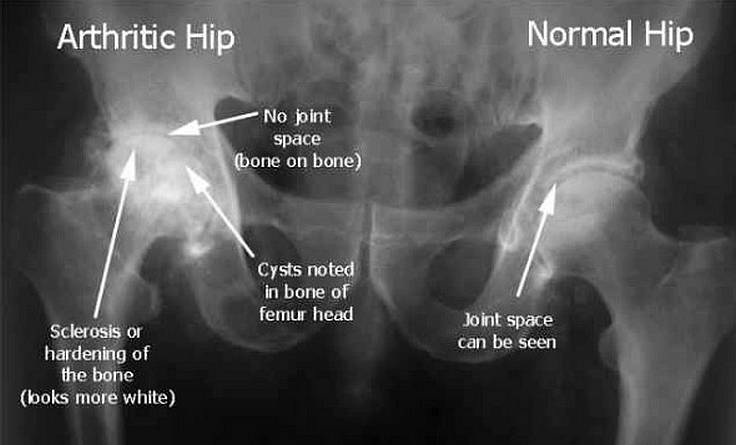Accidents can cause lower limb injuries, such as hip fracture following a fall, trauma from sporting activity is a common reason for patients to visit us. Where pain has come on over many months or years, the most common cause is osteoarthritis.
There are less known diseases, such as osteonecrosis, where the bone in a joint dies away due to poor blood supply. Haemophilia or gout can affect your joints, although they all have a far lower incidence than arthritis.
Damage From Arthritis
You may suffer from swelling, or pain in your joints due to arthritis. The debilitating effect of this should not be underestimated but unseen, progressive damage to joint surfaces is the primary concern.
Osteoarthritis is the most common form of arthritis, to a fair degree age related wear and tear, although genetics and lifestyle also play a part in its development and progression. As in the image below, the wearing away of cartilage is the main feature.

Rheumatoid arthritis, an autoimmune disease, can bring cartilage damage through inflaming the synovial membrane (the lining of the joint). Following injury, post-traumatic osteoarthritis can be triggered in the longer term.
For all types of arthritis in the hip and knee, non surgical care such as corticosteroid injections and physiotherapy can alleviate symptoms. Where damage is too serious for this, effective surgical treatment is available.
This could be arthroscopy (keyhole surgery) of the knee to relieve symptoms, or replacement of the knee joint using a modern implant. Where the hip joint has not responded to non surgical care, an established option is:
Ligament Injuries
Twisting injuries or a direct blow to the knee can damage the ligaments that make the knee work efficiently and hold the joint together. Ruptured ligaments often bring swelling and pain, or at least a feeling of instability.
Tears in the anterior cruciate ligament are the most common, with others seen in the posterior cruciate ligament, medial collateral ligament and lateral collateral ligament. Damage to more than one ligament at the same time is possible.
Where the damage is not extensive, non surgical care led by professional physiotherapy may be sufficient. In more serious cases, surgical repair will normally be viable, a long lasting solution which is not too invasive:
Cartilage Injury
Cartilage is the material which makes up the lining of joints such as the knee and hip, as well as forming the menisci. They are rubbery "shock-absorbers", positioned between the ends of the femur and tibia (thigh bone and shin bone) in the knee.
Both types of cartilage can be damaged by injury, perhaps during sporting activity, or just an awkward twist whilst out walking. Ongoing pain, swelling, or lack of function should be assessed by an orthopaedic consultant.
Non surgical treatment can be feasible but where a structural abnormality is confirmed, usually by an MRI scan requested by your consultant, keyhole surgery may be the best route:
Wider Treatment
There are other conditions we treat, such as dislocation of the patella, which is quite common and can involve ligament damage. Disorders which cause unusual patterns of bone growth (bone dysplasia) are not unknown.
Orthopaedics is an established field, aided by technology such as MRI scans and the knowledge of highly trained consultants. Joint replacement has been around for over 50 years, with surgical materials and techniques advancing vastly since then.
Whatever the issue you are facing, we simply ask that you do not try to put up with a persistent problem. Symptoms are likely to worsen and arthritis to progress. Neither the consequent reduced mobility nor increased pain are desirable and both can be effectively treated.
Our team and all the staff at our Northampton hospital are here to help. You will receive a friendly welcome and individual care whatever the issue.
![]()
Our Body's Powerhouse

The hip is vital for movement although our knee is the primary focus for mobility and weight bearing. Even where repair of existing structures is not possible, normality can be returned:
